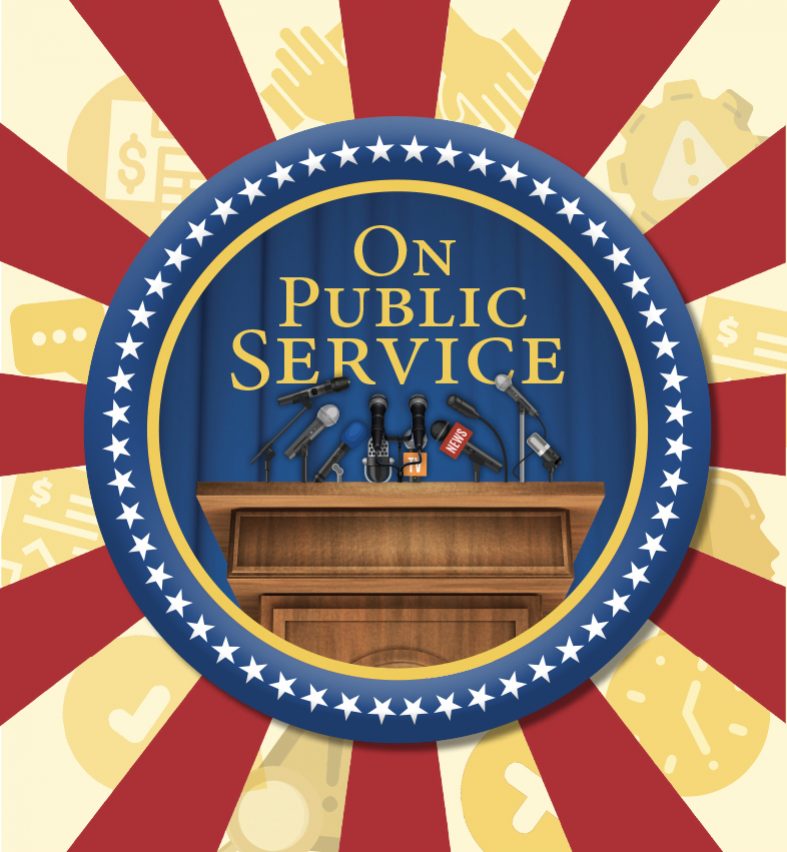By Craig Reynolds
During my stint as an elected official, skills learned as an actuary have proved invaluable
Most actuaries in the United States work in one of four areas:
- Life insurance and annuities
- Pensions and employee benefits
- Health
- Property-Casualty/General
Of course, some actuaries work across disciplines, and, increasingly, some actuaries’ focus is in diverse areas such as risk management, investments, or data analytics. The Society of Actuaries and the Casualty Actuarial Society have worked tirelessly for years to expand the scope of work that actuaries can do and for which we are recognized experts. But one area is largely outside the typical actuarial domain, and perhaps it need not be: Politics.
Over the course of my career, and particularly during my 2015–2016 term as president of the Society of Actuaries (SOA), I encountered many people who had been promoted to C-suite positions who indicated that they were no longer working as actuaries, a sentiment with which I strongly disagreed. While they perhaps weren’t pricing products, doing reserve calculations, or running corporate models, actuaries are also educated and qualified to work in the C-suite just as surely as they are educated and qualified to work in the trenches on modeling and calculations. It is important for actuaries to remember that their actuarial education and skills got them where they are and enable them to do the job they have—no matter how high in the company they rise.
Similarly, some actuaries are involved in politics. Whether in part-time or full-time roles, whether paid or volunteer, they are still actuaries. I believe the skills we develop on the job and through the education and examination process can make us more effective politicians.
There is no central source to identify actuaries who are involved in politics, but a few examples of North American elected actuaries include:
- Claude Castonguay, who served in the National Assembly of Quebec and, later, for two years in the Canadian Senate
- Tim Fitzgibbons, who served as town councilor for Bridgewater, Mass.
- William (Paul) McCrossan, who served as a member of Parliament in Canada for six years
- Wallace McCutcheon, who served in the Canadian Senate from 1962 to 1968
- Bill Sayre, who served on the Pequannock Township, N.J., school board for six years
- Steve Schoonveld, who served on the Mansfield, Mass., Select Board for six years and is currently on the Mansfield School Committee
I have similarly served on the City Council of Mercer Island, Wash., since 2020, and I have found that I frequently employ technical skills developed over my 38-year actuarial career, including:
- Budgeting
- Financial planning and analysis
- Risk management
- Understanding employee benefit programs and compensation structures
Management and people skills are no less important, including:
- Communication
- Consensus building
- Making decisions with limited information
- Keeping an open mind
- Knowing how to pick yourself up after you fail
In the ensuing pages I will address how all of these apply—but first, to give context, I would like to share a little about my personal journey.
My Journey
After seven years on the board of the Society of Actuaries, including four years as a presidential officer, I realized there was more I wanted to do in public service. Just as with board service, and passing actuarial exams, serving as an elected official usually requires the successful politician to work their way up, usually through volunteer service. In my case, this was a three-step process, with each step leading to a natural decision to take the next step. (I am often asked if there is a step after this one, but my preference is to leave those roles to younger and more ambitious public servants.)

In the first step, I volunteered to serve on a community advisory group (“CAG”) that the council had created to study the financial position of the city and recommend solutions. In Washington, city property tax revenue growth on existing buildings is limited to 1% per year, unless there is a voter-approved levy. In our small city, which has a relatively small retail and commercial core, property tax is the most significant revenue source. And the 2010s saw non-trivial inflation in the Seattle area. Approximately 70% of city expenses are employee compensation and benefits, which, sometimes by union contract and sometimes due to competitive forces, must generally increase with the regional inflation rate. This structural imbalance, which is even worse now, creates a problem for most cities. Eventually, most cities must either go to the voters to ask for more money or cut services. Of course, seeking to operate more efficiently is always part of the solution, but there are limits to such opportunities. Over the course of several months, the CAG studied city budgets, evaluated staff-prepared financial forecasts, and debated priorities for the city. Ultimately, a significant majority of the CAG voted to recommend putting a tax increase on the ballot. Ultimately, the council did so … and it was soundly defeated. This was a tough learning experience related to the challenges of governance.
After my service on the CAG, I again answered a call for volunteers and put my name in for service on the Planning Commission. This is one of the most important city volunteer groups, as it is in charge of studying land-use policies and recommending changes to such policies to the council. While the council does not always act in a manner completely aligned with Planning Commission decisions, its actions are generally closely aligned with these recommendations. Tip O’Neil famously opined that “all politics are local,” but a corollary that “local politics are all land use” would be only a slight exaggeration.

Finally, after about a year on the Planning Commission, I decided to run for city council. My main motivation for running was that I wanted to be sure that my city could remain a full-service city—with locally controlled police and fire, functional utilities and transportation infrastructure, a comprehensive community- and school-based counseling program, and a beautiful playground and park system. I felt that my actuarial training and experience would qualify me to do this job well, just as it had in my work on the CAG and the Planning Commission.
Technical Skills
My education and experience as an actuary prepared me for both the technical challenges and the personal and interpersonal challenges. Let’s consider the technical challenges first.

Budgeting
By state law, the city must have a balanced budget. The city budgets on a two-year cycle. The budget book is a thick three-ring binder reminiscent of some of the exam materials that I used to study from. Terminology and procedures are similar to those used at insurance companies that many actuaries are used to, with subtle differences. Notably:
- Instead of surplus, we monitor “fund balance.”
- We never talk about “earnings,” just revenue and expenses, and a net change in fund balance over the time period.
- We consider the budget to be “balanced” if the opening fund balance and revenues are sufficient to cover operating expenses, including debt service, even if the fund balance is projected to decline over the year.
- We manage finances on a “fund” basis, loosely analogous to a company managing things on a Line of Business basis. For example, we separate the general fund from the street fund and the utility funds.
My actuarial experience has prepared me to understand budgets, to critically evaluate underlying assumptions, and to identify internal inconsistencies and questionable assumptions.
Financial Planning and Analysis
Most insurers, and many actuarial employers, have a team dedicated to doing financial forecasting. Cities are no different. Some of the same skills are required to set the assumptions for these forecasts. Examples include:
- How many homes will sell in the community over the biennium, and at what price? (This impacts our Real Estate Excise Tax [REET] income.)
- What will inflation rates be?
- How much of a contingency reserve should be set aside to provide for unforeseen adverse experience?
- How much will we earn on our investments? (In my city, we don’t have big “reserves” or surplus that bulk up a balance sheet, but we do have enough money set aside for contingencies and long-term utility and capital improvement obligations that this assumption matters.)
- How will the economy impact our business and occupation tax income?
Notably, unlike the 5-, 10-, or 30-year forecasts that insurers do, our city only does a deep dive two years out in the future, though we look six years out for some purposes.

There have been a few frustrating parts of this experience for me. One is that it is city staff that does the forecast, and it is their job to set the assumptions, not the council’s. Nonetheless, I find it helpful to be able to gauge the conservatism or aggressiveness in the forecasting as I consider whether or not to propose changes to city services that have budget implications. And, on occasion, my analysis of and commentary on the presented forecasts has led to forecast revisions by the staff.
Secondly, many tools that actuaries would find useful in analyzing performance, like a source of earnings analysis, or a fund roll-forward, are not usually prepared by my city. This makes it much harder to understand drivers of fund balance movements and differences between budgeted and actual performance.
While it is rare for my city to look more than six years in advance on a comprehensive basis, certain costs—such as building repair and replacement, fire truck replacement, and water main upgrades—are significantly more long term than this, and the actuary can bring skills to the table to ensure that the can is not just kicked down the road.
Risk Management
Like insurers, cities also face risks. First, they face financial risks, in the form of unplanned expenses or unexpected drops in revenues. While there is no explicit risk-based capital requirement, cities in my state commonly set aside a contingency reserve of around two months of expenditures. When the COVID-19 pandemic hit, we faced hard decisions. We knew there was potential for significant reduction in sales tax, business and occupation tax, REET, and fee income from parks and recreation facility rental fees. We had many hard discussions about how to deal with these potential revenue drops. We could have chosen to budget for them by spending down the contingency reserve and our current unassigned fund balance, but because we did not know how bad the impact would be, and how long the pandemic would last, we instead made significant cuts in staffing. While these decisions were hard, the city came through the pandemic stronger than it otherwise would have. Federal and regional grants to cities helped significantly as well.

Cities also face other risks, including litigation risks and environmental risks. We have a good emergency management plan, with many trained local volunteers to deal with a variety of risks, and that system served us well as we adapted to the COVID-19 pandemic. But we also must consider that we live in an area that is arguably overdue for “the big one”—a potentially catastrophic earthquake. In such a scenario, city facilities and emergency management capabilities might be unavailable exactly when they are most needed. An actuarial skill set is well-suited for recognizing and planning for these possibilities.
Employee Benefits and Compensation
In my experience, government salaries tend to be lower than those for comparable private-sector positions, though this is not always the case. Helping to offset that, at least in our city, is a benefit program that is usually more generous than most private-sector plans. Most of the pension obligations are funded at the state level, so the city council does not need to make funding decisions. But there are notable exceptions, one of which is quite interesting, and quite generous. The Law Enforcement Officers and Firefighters Pension Fund had a period of time when it offered an extremely generous post-retiree medical plan that was funded by the cities or counties where these officers worked. The plan covered all medical costs, with no copay or deductible, including long-term care, Medicare premiums, and physician and hospital charges. While the city obtains a biannual study of projected costs for this program, my understanding is that there is no legal obligation to prefund these very-long-tailed liabilities, and when I joined the council, there essentially was no prefunding. I was proud to work with staff and a subcommittee of the council to develop a plan to gradually accumulate the required funds on a levelized basis.
While such prefunding is not required, as a city council, we need to consider two key reasons why prefunding is wise. First, not prefunding such expenditures, which are projected to eventually grow to a material share of city revenues, would be, in my view, fiscally irresponsible, likely leading to required cuts in city services during peak cash outflow years. Second, we should consider the equity implications. This benefit program is essentially a payment for police and fire services provided in the 1970s. I believe it would have made sense for the benefits to be funded by the taxpayers that benefited from these services. It is too late for that—but with the actions we are taking, we keep that problem from getting kicked to the next generation.

As we worked on this problem, I found it helpful to consult with the Actuarial Board for Counseling and Discipline. I am a life actuary, and, as such, I do not meet the qualification standards to provide employee benefits or medical insurance professional services. I know that the Code of Professional Conduct and actuarial standards of practice still apply to me, even though in some sense I am not acting in the capacity of an actuary. (Note that the qualification standards apply even to volunteer labor, or very low-paid part-time labor like city council service.) That said, I recognized that as a life actuary I was not qualified to provide actuarial opinions on employee benefit program funding according to our professional standards, but I was more qualified than the rest of the council to understand the implications of actuarial reports and analysis that the city obtained. In effect, I got comfort with the idea that, while I could not perform an actuarial valuation of post-retiree claims, I could help advise the council on the implications of that report and help strategize on how to react to it.
Management Skills
Of course, it is not just the mathematical / modeling / technical skills that define a good actuary. Most actuaries have people skills that apply in government just as much as they do in the private sector—and in some cases more.
Communication

The actuarial curriculum has dramatically increased its focus on written and oral communication over the span of my career, and I think that is for the better. As a government official, one needs to be able to form cogent arguments, articulate policy positions, and educate residents on city activities. At times, while dealing with contentious issues, I have received dozens of constituent emails a day. While I was not always able to answer all of them, I tried. I also maintain a Facebook page where I regularly update my community on what is going on with the council, and I think that has been much appreciated.
These skills are arguably even more important on the campaign trail, where I had to overcome my natural introversion and knock on thousands of doors to engage with voters, participate in public debates, and create a campaign website. The campaign for re-election just kicked off, so it is time to dust off some of these skills.
Consensus building
A single city councilmember can do virtually nothing alone. Making legislative progress requires building coalitions and compromise. While I am not as skilled at horse trading as a more seasoned politician might be, I work hard with my colleagues to arrive at consensus strategies to address city challenges. In this effort, we face one constraint not faced in the private sector. Washington’s Open Public Meetings Act generally prohibits me from meeting, even serially, or corresponding with a quorum of the council outside of our scheduled and noticed public meetings. This limits my ability to negotiate in advance of a vote.
Making decisions with limited information
Actuaries need to make decisions with limited information virtually every day. We regularly prepare forecasts that depend on key assumptions, where the only thing we know for certain is that emerging experience will not exactly match our expectations. A city councilmember often needs to make decisions in reliance on forecasts that are in turn based on assumptions that may not be consistent with reality as it unfolds.
Keeping an open mind
Many city issues are complex, with undesirable outcomes associated with any decision. I try to approach any issue the city is facing with an open mind, consistently with the principles of the actuarial control cycle. Before drawing a conclusion, it is essential to gather information and understand the problem, potential solutions, and implications of the solutions.

Often, the city has limited tools in its arsenal to address complicated problems, and when you have a hammer, sometimes even screws look like nails. I have worked very hard in my tenure to take my time to find the best solution for the problem at hand.
Knowing how to pick yourself up after you fail
No one has a political career where everything goes as desired. Council votes are sometimes 6-1 or 5-2, and I sometimes find myself on the losing end. Sometimes I am baffled by why the votes went as they did. When that happens, it is critical to not take defeat personally, and find a way to move on, because there is never a shortage of new problems to solve. In my professional career, these sorts of defeats have been rare, but there is little that could prepare one better than the actuarial exam system!
An Option for You?
Irrespective of where you are on the political spectrum, we likely share a desire for effective and efficient government operations. As an actuary, you can bring skills to the table to help achieve this goal. My team at Milliman uses 29 different “fundamentals” to guide our behavior. One of these is “give back to the profession.” We act on this fundamental by doing research, speaking at meetings, writing articles, and serving on task forces, committees, and boards. But I believe that an even broader goal of “give back to the community” are consistent with the obligations of a profession.
CRAIG REYNOLDS, MAAA, FSA, is a principal and consulting actuary at Milliman in Seattle, and serves as city councilmember for Mercer Island, Wash.





